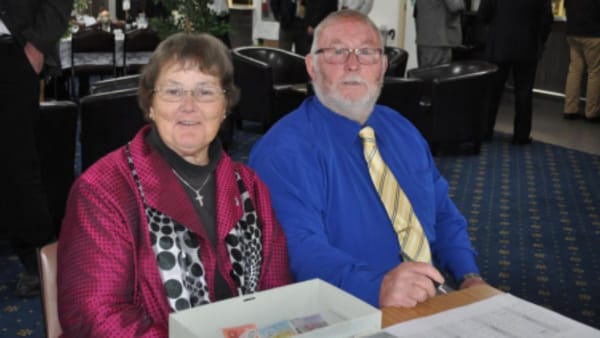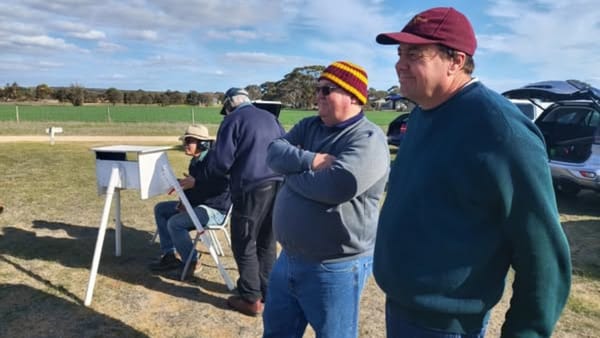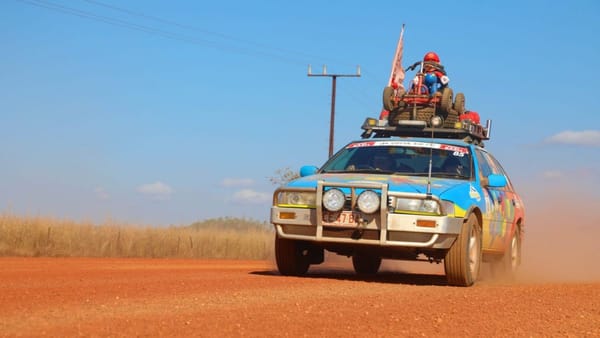Mystery solved at Caloote as 19th-century pioneer’s grave site found
Christine Eichler had hoped to find out where her grandmother went to school. Instead, her research led her to the final resting place of Carl Christian Rathmann.

Locals support locals – that’s why this recent post is now free to read. Your support can help Murray Bridge News tell important local stories. Subscribe today.

The sun beats down on a dusty cemetery at Caloote, a little town on the River Murray, as 15 or 20 people gather around an unremarkable earthen mound.
Only about half of the graves at the cemetery have headstones; and many of those that do are covered with gothic German script, a throwback to the area’s colonial past.
For 113 years, this particular grave has looked just like any of the others.
But on Saturday, the man lying interred here was given a headstone at last, in recognition of his contributions to the area.
Without him, the cemetery – and the township a few kilometres up the road – would never have existed.

Prussian pioneers made a life beside the River Murray
Carl Christian Rathmann was born in Gross-Glogau, Prussia, now the Polish city of Głogów, in 1822.
He and his soon-to-be wife, Malvina Hanckel, emigrated aboard the Pauline in 1846, settled in the Adelaide Hills.
Within 10 years they had established the Napoleon Bonaparte Hotel at Blumberg, now the Blumberg Hotel at Birdwood.
They also established a family, though three of their six children died young: their first was stillborn, their second died before turning one, and their third died of typhoid at the age of seven.

In 1872, the year Mr Rathmann turned 50, land was made available for settlement along the River Murray and the family decided to move east.
They cleared, fenced and stocked their new property, south of Reedy Creek and west of the River Murray, and named it Kaalut, apparently after an Indigenous word meaning “bend in the river”.
Life wasn’t easy for the pioneers – they had to build their own home and shelters for their livestock, produce most of their own food and rely on paddleboats for mail and supplies.
Locals support locals. Your support helps Murray Bridge News tell important local stories.
When they took delivery of a winnower, instead of using a horse, Mr Rathmann supposedly pulled it half a mile uphill to the homestead by himself.
By 1885, though, they had laid out a plan for a township on their land.
By the time Mr Rathmann retired at the age of 80, just after the turn of the 20th century, Caloote boasted several houses, a post office, a general store and even a wine bar.

Malvina Rathmann died in 1904, but – if you can believe it – Mr Rathmann remarried twice more.
His second marriage, to a Jessie McPherson, more than 20 years his junior, ended upon her death four years later; he then married an Eliza Daley on December 29, 1909.
Just six days later, on January 4, 1910, Mr Rathmann died of heart failure.
“He was a goer,” someone called out at Saturday’s gathering, to a few half-stifled laughs.
As well as his widow, he was survived by two sons, a daughter, 29 grandchildren and a great-grandchild.
His descendants include local members of the Mau, Kubenk and Wegener families.

Great-great-grandchild’s question started her quest
Mannum resident Christine Eichler, who recounted Mr Rathmann’s life story at the cemetery on Saturday, never set out to discover all this history.
All she had wanted was to find out where her grandmother went to school.
However her efforts to research the history of Caloote and nearby Milendella led her in another direction.
As it turned out, Mr Rathmann was her great-great-grandfather.
“I was digging and digging … and found out all this information about the others,” she said.
When Caloote resident Trevor Kubenk found out she was trying to find the pioneer’s final resting place, he agreed to pay for a headstone to be put there.
So on Saturday, a small crowd gathered at the dusty cemetery to see it unveiled.
Among them were two of Mr Rathmann’s great-great-great-great-grandchildren, oblivious to the significance of this lump of earth they played around – but happy to enjoy a bit of streusel cake in the afternoon sun.






